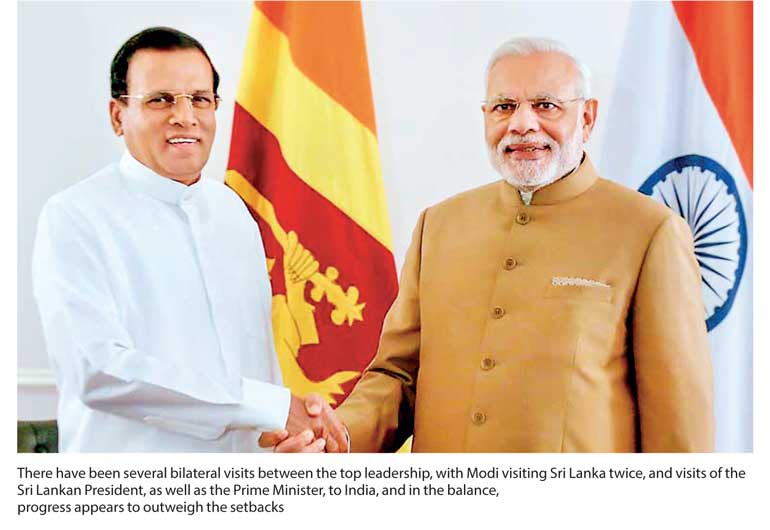Friday Dec 05, 2025
Friday Dec 05, 2025
Thursday, 14 December 2017 00:00 - - {{hitsCtrl.values.hits}}
 The relationship between Sri Lanka and India has always been characterised by surprises, setbacks and progress, and the three years of the Modi Government in India have not been an exception. There have been several bilateral visits between the top leadership, with Modi visiting Sri Lanka twice, and visits of the Sri Lankan President, as well as the Prime Minister, to India, and in the balance, progress appears to outweigh the setbacks.
The relationship between Sri Lanka and India has always been characterised by surprises, setbacks and progress, and the three years of the Modi Government in India have not been an exception. There have been several bilateral visits between the top leadership, with Modi visiting Sri Lanka twice, and visits of the Sri Lankan President, as well as the Prime Minister, to India, and in the balance, progress appears to outweigh the setbacks.
Trade between Sri Lanka and India was a healthy $ 4.6 billion in 2016, with the greater exports from Sri Lanka improving the trade balance to 6:1 from 9:1 in 2008. There are a number of manufactured goods that have found a ready market and consumer acceptance in India. These include garments and innerwear, furniture, bicycles, display refrigerators and, quite importantly, chicken sausages. The latter are a rage in South India, and the quality of the Sri Lankan products have pushed Indian manufacturers to improve their own quality to compete with the imported products. There is also demand for fruits from Sri Lanka, including strawberries, passion fruit, mangosteen and rambutan.
Sri Lankan companies are also investing in India, with companies like Brandix, MAS Holdings, John Keells, Hayleys and Aitken Spence having a presence in India. In return, Indian companies like Asian Paints, Dabur, and Piramal having a manufacturing presence in Sri Lanka. There is also Indian investment in IT, financial services, real estate, hotels, banking, mobile services, cement and infrastructure.
The Colombo Port accounts for 12% of all transhipment cargo to India, and Sri Lanka exports more than 4,000 product lines to India on a duty free basis. Business leaders that I met on my visit were generally positive about the commercial prospects of doing business in India.
They did say that India was a difficult market to break into, but perseverance had significant rewards. The complaints were about non-tariff barriers, the lack of standard operating procedures, the food standard restrictions and lack of testing and clearing facilities, problems of certificates of origin, as well as the quantitative restrictions on garments, vanaspati and some spices.
There is also recognition of a substantial informal trade that exists between the two countries. There are close to 100 flights every week between South India and Colombo, and there is a lot of informal trade happening through this. It includes saris, lungis and utensils from India and cigarettes and liquor from Sri Lanka.
In addition to this passenger-based trade, there is also trade through large boats, mostly from off Tuticorin in southern India, carrying cement, steel, and engineering goods including automobile parts and ancillaries. This is mostly a cash trade, and does not figure in the official calculations, with both countries losing out on tariffs and customs. Apart from this, such a cash trade gives rise to hawala transactions and to smuggling from both the sides.
At the Government level, India has been investing in infrastructure, having built several thousand houses in the northern part of the country. India has investments in roads, railway track renewal, hospitals and a stadium that was inaugurated during Modi’s visit. A development credit line of $ 2.6 billion has been made available by India of which $ 436 million is aid.
On the flip side, there are issues on the Indian side as well as the Sri Lankan side. On the Indian side, there is an  attempt to view Sri Lanka relations through the prism of security of the neighbourhood, and the concern about the scale of Chinese investments in the country.
attempt to view Sri Lanka relations through the prism of security of the neighbourhood, and the concern about the scale of Chinese investments in the country.
There is a significant difference between Indian assistance and the Chinese efforts. The Chinese assistance comes along with constructions and delivery of the infrastructure, whereas the Indian assistance is more in nature of funds and technical assistance that has to be contracted out for construction after due process. There is naturally an adverse comparison about the speed of execution. Quite apart from this, the politics of Tamil Nadu has constrained the Indian Government in acting with greater effect in Sri Lanka, a fact that has been noted in Colombo.
In Sri Lanka, there is an obsession with whatever is happening in Tamil Nadu, and businesses constantly try to get a foothold in that state. During my interactions, I pointed out that other states in south India, especially Andhra Pradesh, Telengana and even Kerala, would be much more welcoming of Colombo business initiatives, and would be ready to offer facilities and concessions that could rival those of Tamil Nadu, and perhaps be even better. It appears to make sense for Colombo businesses to focus on southern states of India other than Tamil Nadu.
There is also an alternate approach possible to expediting the talks on the Free Trade Agreement. Current discussion focuses on the list of items, both goods and services, as well as quantities and tariffs related to these. The real problem appears to be at the implementation level. If the negotiations were to focus on the clearance of these non-tariff bottlenecks, it would enable a commitment on the time out of port that would speed up the trade considerably.
For food standard approvals, discussions are already taking place on granting approval to Sri Lankan laboratories for granting pre- shipment approval that would be accepted for clearance of goods. It is possible to extend this idea to cover the entire implementation bottleneck and focus on these during negotiations.
Geographically, it is inevitable that trade with India will continue to grow. It is governed by proximity, history and millennia of trade relationships. What is lacking is mutual trust and a confidence that a combined future will be a more prosperous one for both. The relationship has to be built on a new normative agenda, for the years of non-alignment are gone.
Modi is pushing concepts of a softer culturally-linked India—at the inauguration of the Doriappa Stadium, there was huge display of yoga with hundreds participating. It is important to find a way forward that would be rewarding to both the economies.
[The writer is the former Finance Secretary of India. This column is based on his recent lecture titled ‘India-Sri Lanka Economic Relations in Modi’s India’ organised jointly by the Lakshman Kadirgamar Institute of International Relations and Strategic Studies (LKI) and the Institute of Policy Studies of Sri Lanka (IPS).]